m (Reverted edits by 213.120.234.109 (talk | contribs | block) to last version by JPDurzel) |
m (Protected "Musket": Excessive vandalism ([edit=autoconfirmed] (expires 23:21, July 31, 2015 (UTC)) [move=autoconfirmed] (expires 23:21, July 31, 2015 (UTC)))) Tag: rollback |
(No difference)
| |
Revision as of 23:21, 31 January 2015
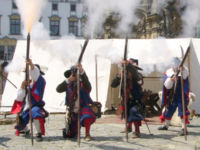
Musket firing from a recreation of a Thirty Years' War battle.
The Musket is a type of firearm that typically featured a long, smoothbore barrel and fired either a musket ball or (from the 1840's) a Minie ball. The Musket was heavily developed during its 4 centuries of use from the 1400's to the late 1800's, with different types of muskets evolving. The name "musketeer" is often applied to the user.
History
The earliest reference to the Musket is found in 1260 in the region now named China, referred to as a "Hand cannon". This device originally fired what was effectively a firework, before the design was refined to include a primitive stock, safer loading mechanisms/systems and, ultimately, the development of the Matchlock musket, the very first firing mechanism that allowed the musket to be built. China became the leader in firearm technology in this era, before European nations developed the design and outpaced them.
In Europe the Musket began to appear on a wide scale in the 15th century, used not only for its firearm purpose but also its psychological impact (the loud noise, in reality had a greater effect on the enemy then the actual firearm itself did). In Hungary the direct decendent of the Musket, the Arquebus, was developed in the 15th century, a smoothbore, muzzle loaded, matchlock weapon that provoked the development of the Musket as its potential power became recognised (particularly as the Arquebus could penetrate the 15kg armor of a pikeman, prompting an increase in armor to 25kg.)
The matchlock mechanism was sometimes replaced by a wheellock mechanism, which utilised a steel wheel which was spun to produce sparks to ignite the powder in the breech. This was an improvment on the Matchlock and the first instance of a firearm being capable of self-ignition. However with the invention of the flintlock mechanism, the matchlock and wheellock mechanisms would soon disappear.
The Flintlock mechanism (eventually) became the definition of a musket, first appearing in the 17th century (credited to Swede Sven Aderman) and spreading across Europe. The flintlock mechanism used a piece of flint held in the hammer which (when the hammer was pulled) would strike a steel plate above the flash pan, igniting the powder in the flash pan which would then ignite the charge.

The Charleville Model 1766 Musket of French origin
Famous examples of the flintlock musket include the British Brown Bess (the longest serving firearm in history) and the Charleville Musket (which would form the basis of other designs for well over a century). The earliest rifles also began appearing in the era of the flintlock musket, in around 1750 in Europe, with new units commonly named "Jagers" ("Riflemen") using them.
The Flintlock would eventually be replaced, after nearly 200 years of use, by the cap/percussion lock, which used a percussion cap (struck by the hammer) to ignite the powder charge, rather than the sparks of the flintlock mechanism. Along with the percussion lock mechanism came, almost immediately, the Rifled Musket using a rifled barrel to use (from 1847) the Minie Ball, designed specifically for use in rifled barrels, greatly improving accuracy.

The Dreyse Needle gun of Prussia
The era of the musket ended with the emerging use of breechloading rifles, which began to appear in the 1840s (the Norwegian made Kammerlader and Prussian Dreyse Needle Gun to name two of the earliest widely used examples). Although the M1819 Hall rifle had been developed in the 1810s, it was not until the Dreyse Needle Gun dominated the Austro-Prussian War in 1866 that the breechloading rifle came into the fore. Although the name "musket" would be applied to the earliest breechloading rifles the practice was dropped as the era of the rifle began.
Musket Types
The Musket saw centuries of development. From the early 13th century with the "Hand Cannon", to the "Rifled Muskets" of the mid 19th century, the Musket was developed continously during the ages, with various types emerging.
Matchlocks

A matchlock rifle.
The Matchlock Musket effectively used a slow burning twine, clamped in a vice, which was ignited (via a match) which would touch the powder in the flashpan when the lever (or later trigger) was pulled. This was a crude design and unreliable at best, but showed the potential of the Musket, and prompted its development.
Wheellocks
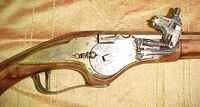
A wheellock rifle.
A design which used a high-friction steel wheel to generate sparks (when it was spun) to ignite powder in the flash pan. Appearing in the 1500s the Wheellock was a more complicated, yet more reliable, alternative to the Matchlock mechanism, improving the versatility of the Musket.
Snaphance
The Snaphance is the little known, short lived step between the Wheellock and Flintlock mechanisms. Virtually identical to the flintlock mechanism, the Snaphance used a flint clamped to a cock that would strike, when the hammer was pulled, a steel plate and ignite the powder in the flash pan. This design formed the basis of the flintlock mechanism and was among the first weapons to feature some forms of safety to prevent accidental firing (albeit limited to later models).
Flintlock

The British "Brown Bess" Long Land Pattern Musket
The Flintlock Musket was, by far, the most famed and most widely used design of the musket. Like the Snaphance Muskets the mechanism used a flint, located in a cock/hammer to strike a steel plate (although the design of a flintlock was much less complicated with fewer moving internal parts and springs). The most well known Flintlock Musket, the Brown Bess, would become the longest serving long arm in military history, used from the 1820's until the late 1860's (in some form) by the British Empire. The Flintlock also had a cultural impact (un-surprising given its 200 years of use) with military terms such as "Flash in the Pan" and "Lock, stock and barrel" emerging with Flintlocks and lasting until the modern day.
Percussion Lock (Cap lock)

A close-up view of the percussion lock mechanism on the Springfield Model 1842 Musket
The Percussion lock (or Cap lock due to the use of a percussion cap used to ignite the charge) was the last mechanism to be developed for the Musket, replacing the flintlock mechanism. Using a hammer attached directly to the trigger to strike a percussion cap (located on a hollow nipple above the charge in the breech) to ignite the charge, the Percussion lock mechanism was an improvement on the old flintlock mechanism, not least due to its wet-weather usage.
Rifled Musket

The Minie Rifle of France, the first rifle to use the Minie Ball.
Emerging on a wide scale soon after the Percussion lock was developed (although the first "Rifles" had been built as early as the 1750's) the Rifled Musket was designed around a brand new ammunition named the Minie Ball, which was designed to deform when the powder was ignited to engage with the rifling and cause it to spin, improving accuracy, massively, compared to older firearms. The earliest of these was the Minie Rifle (designed for the Minie Ball) which would form the basis of the majority of Rifled muskets until they were replaced by breechloading rifles in the late 19th and early 20th centuries.
Ammunition
As muskets evolved during their life time the ammunition that they fired developed as well. From the original ball of stone or lead, lauched by black powder (which was often poured into the barrel through a powder horn) to the use of metallic cartridges with specific bullet shapes, the musket provoked more development in ammunition as the musket itself developed.
Projectiles
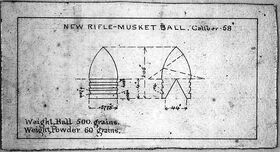
A pattern image for the Minie Ball.
Muskets, in general, fired one of two types of ammunition. Originally muskets fired the appropriately named Musket Ball which could be made from stone or, most commonly, lead. This lead ball was soft enough to deform slightly when the powder (which was typically held in a paper cartridge) was ignited, before fully deforming when it struck the target.
Later, in the mid 1840's, experiments with soft-lead bullet designs led to the evolution of the rifled musket. The most popular and most widely known of these bullet designs was the Minie Ball, which was designed to deform in a specific shape, allowing it to engage with the rifling in the barrel to enable the Minie Ball to twist, granting better accuracy.
The last of the firearms that could still be loosely referred to as muskets would eventually fire metallic cartridges, particularly following the widespread use of breech loading. The most notable instances of this were the earliest "Trapdoor" Springfield Rifled Muskets (ie the Springfield Model 1866) which were chambered to accept the .50-70 Government cartridge (and the later the .45-70 Government, still in use today).
Cartridges
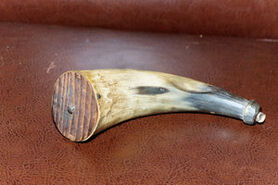
An antique Powder Horn
The Musket originally lacked any form of cartridge, with the powder being poured directly into the barrel with the ball being forced into the barrel using the ramrod. The powder was often poured into the barrel via a Powder Horn which was quite literally a bull or buffalo horn (which are naturally hollow) which effectivelly formed a funnel to better pour the black powder.
Later paper cartridges came into vogue in the mid to late 18th century, containing the blackpowder and occasionally contained the ball as well. The seal around the ends of the paper cartridge, particularly those that contained the projectile as well, was often lubricated and sealed with grease. This factor was instrumental in the India Mutiny of 1857 as a rumor surrounding the origin of the lubrication of the Minie Ball used with the Pattern 1853 Enfield caused much distain.
Eventually metallic cartridges would emerge, with the last of the muskets utilising them. It must be noted however that the majority of firearms using metallic cartridges could not be truly named muskets as they had rifled barrels and were loaded via the breech.
Classification
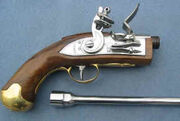
Photo of a flintlock igniter.
As more gunlock types were created, the overall shapings and forms of individual musket types were very different. The side of a Wheellock rifle was normally larger since the lock plate had more parts in it, with older designs such as the Matchlock not having a trigger guard.
Later, with the introduction of rifling on a widespread basis, the term rifle and musket became rather blurred. Although units had previously been identified as riflemen (in Europe, particularly in Germanic territrories, these men were named Jagers) once rifling became standard across virtually all firearms these units effectively evolved into modern day Sniper units (a role which they fulfilled the equivalent of at the time). Manufacturers, particularly the Springfield Armory, continued to sell their products as 'Rifled Muskets' right until the turn of the 20th century, while other manufacturers sold their designs as rifles.

The Springfield Model 1873 an example of a ("Trapdoor" Springfield) rifle, yet was sold as a "rifled musket"
Specifically a musket is often referred to as a smoothbore (ie lacks rifling), muzzle loading firearm with a long barrel. Obviously a rifle is defined as a rifle because it has rifling cut into the barrel, although as mentioned above manufacturers would often ignore this fact, classifing their designs as muskets despite having fulfilled the defenition of a rifle. In truth the classification of whether a firearm is a musket or a rifle is largely due to interpretation, with general concensus being that the musket was no longer in production or military use after the Great War (1914 - 1918).